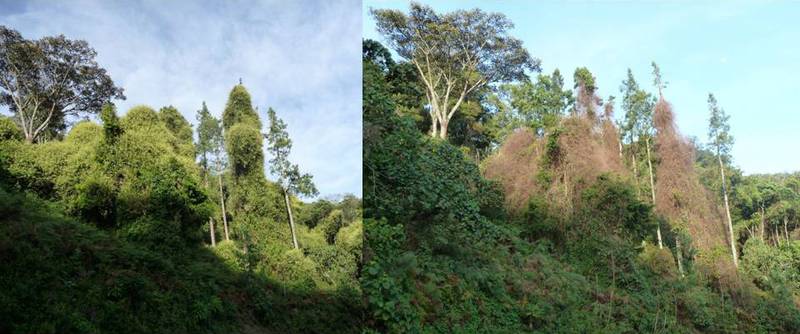Impact of Sericostachys scandens
Categories: Journal no. 41, Ecology, Democratic Republic of the Congo, Kahuzi-Biega
In November, 2004, WCS and ICCN teams surveyed the highland sector of the Kahuzi-Biega National Park where they found at least 168 gorillas. The survey also triggered the following observation:
"The well-being of the gorillas will depend not just upon patrolling, but also upon availability of suitable habitat. The highland sector of the park is currently undergoing an apparent explosion of Sericostachys scandens, a native but invasive liana not eaten by gorillas or chimpanzees. The liana has colonized recent openings caused by fire and cutting, and is now overtopping adjacent canopy, killing trees and bamboo and creating large mono-dominant prairies that are not favoured by the apes. While the causal linkages leading to Sericostachys expansion are not yet known it evidently represents a threat to gorilla habitat, and a potential constraint on the recovery of gorilla populations in the highland sector of the park." (Hart and Liengola 2005)
As in Kahuzi Biega, also in Nyungwe National Park (Rwanda) at some 100 km away, the proliferation of Sericostachys scandens, especially in the period 2007-2009, has caused widespread concern on its impact on the ecosystem. S. scandens is a native, monocarpic liana in Afromontane forests that mass flowers and dies back approximately every decade. It often covers trees, clearings and road edges, possibly causing tree mortality and impeding regeneration. Concern over such impacts, visible from the national road connecting Butare with Bukavu (Democratic Republic of the Congo), has led some politicians and members of the public to demand interventions to control the liana. This concern and the resulting polemic have challenged decision makers, including those at high levels. In contrast, from other Afromontane forests in the Albertine Rift where S. scandens occurs, including the Virunga and Bwindi massifs, home to mountain gorillas, no proliferation of S. scandens has been reported, despite its abundance at the peak of its flowering cycle.
The high level concern on its possible proliferation motivated the organization of an international workshop on 24 September 2009, by the Rwanda Environment Management Authority, in collaboration with the Rwanda Development Board (in charge of Rwanda's national parks) to reach consensus among the diverging opinions held by researchers and managers about the proliferation of S. scandens in Nyungwe. The main results were reported in Scholte et al. (2010).
The workshop began with one overarching question: is S. scandens functioning within its historical parameters or has something triggered the recent proliferation, thus justifying interventions? Just over half of the participants considered the liana's proliferation to be within its natural range of variability.
S. scandens, a pioneer species dominating open areas, appears to be most abundant in eastern Nyungwe National Park. This most likely reflects recent human disturbances and may explain why this liana appears to have increased. Monitoring in the forest interior shows that following postflowering dieback of the species in 1994 other species increased rapidly in areas vacated by the liana. Ten years later, cover of S. scandens had reached pre-dieback levels, but is currently (September 2010) showing massive dieback.
Various observers noted spatial variation in flowering events at different places in Nyungwe at varying times, as well as at varying periods between different forests. Early explorers reported that S. scandens was already abundant in Nyungwe in 1898 and 1907, despite the presence of elephants and buffaloes, refuting assumptions that the recent extirpation of these species triggered the proliferation of S. scandens. Observations from Bwindi suggest that while elephants occasionally feed on the liana they also favour habitat suitable for S. scandens by maintaining open areas. Participants agreed that reintroduction of elephants to Nyungwe would not suppress S. scandens. To understand the influence of S. scandens on forest dynamics and composition, monitoring of cover and abundance over the complete multi-annual life cycle of the species was recommended. The greatest knowledge gap appears to be the impact S. scandens may have on forest regeneration but there is also a need to document its local distribution.
Participants concluded that political will for action and slow recovery of disturbed areas justify trial interventions that should consider: reduction (not elimination) of S. scandens, experience with ongoing forest regeneration trials, experimental cutting in highly visible places (e.g. along the national road), and the anticipated dieback conditions following the current flowering.
The workshop concluded that the earlier polemic on S. scandens was related to the limited information available and poor communication between scientists, managers, decision-makers and the public. The proposed trial interventions represent a timely opportunity to address these deficiencies.
Paul Scholte
References
Hart, J. & Liengola, I. (2005): Post-Conflict Inventory of Kahuzi Biega National Park. Gorilla Journal 30, 3-5
Scholte, P. et al. (2010): Reaching consensus: Impact of the liana Sericostachys scandens on forest dynamics in Nyungwe National Park (Rwanda). Oryx 44 (3), 325-326. © Cambridge Journals, excerpts reproduced with permission.

